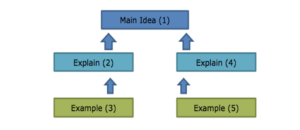In the following activities, you are asked to identify the main ideas and supporting details of different paragraphs. When you are done, check your work against the “Main Ideas and Supporting Sentences” Practice Activity Answer Key.
Last time we covered what a main idea sentence is: a sentence that tells the reader what the paragraph is about. The rest of the sentences in the paragraph support the main idea sentence. “Support” means that the sentences either explain a detail of the main idea or give an example. Read the paragraph below. The main idea is underlined. The “support” that explains is bolded, and the “support” that offers an example is in italics.
My parents were very strict when I was growing up. My mother in particular was always correcting my behavior. One day when I forgot to look both ways as I was crossing the street, my mother made me go back home; she said that I could not go out at all if I could not be safe. My father was more concerned with my grades. Every night he would make me go to my room before I could watch television.
Let’s examine this paragraph.
The first sentence (1) presents the main idea: “my parents were very strict.” The second sentence (2) explains what I consider “strict” by saying that my mother frequently corrected my behavior. The third sentence (3) offers an example of how she would correct my behavior. The fourth sentence (4) explains further that my father was strict when it came to schoolwork, and the fifth sentence (5) offers an example of how he was strict.
If we were going to diagram the paragraph, it would look like this:
One way to talk about whether sentences directly support the main idea (as the second level does), or indirectly support the main idea (the bottom level) is to call them MAJOR detail sentences and MINOR detail sentences. Major details directly explain something about the main idea. Minor details offer examples that illustrate major details.
Practice I: Read the paragraphs, and then identify each sentence as a main idea, a major detail, or a minor detail.
Paragraph 1:
Single parents have to overcome many obstacles to return to school. If their children are very young, finding quality babysitting can be difficult. Many babysitters are unreliable, and that can mean that the parent has to miss many classes, which can hurt their grades. It is also hard to find enough time to study. Children require a lot of attention, and that can interfere with a parent being able to complete their homework. Finally, raising children is expensive. Many single parents discover that they can’t meet the costs of both raising children and paying for tuition, books, and fees.
Sentence #1:
Sentence #2:
Sentence #3:
Sentence #4:
Sentence #5:
Sentence #6:
Sentence #7:
Paragraph 2:
My grandmother turned 70 last year and celebrated by going skydiving. She said she always wanted to skydive and figured it was now or never. Many people think that when you get older you can no longer do fun things, but this is not true. The senior center in town offers dance lessons and also takes groups to the art museum. The classes are always full because so many people want to try new things. Towns are even developing senior living communities around activities such as golf and tennis. Those communities are very popular because people like to live with others who share their interests.
Sentence #1:
Sentence #2:
Sentence #3:
Sentence #4:
Sentence #5:
Sentence #6:
Sentence #7:
Practice II: Below you will find several main idea sentences. Write your own supporting sentences by using major and minor details.
- It is not a good idea to watch a lot of television.
Major:
Minor:
Major:
Minor:
- Coaches have good reasons to be firm with the players on their team.
Major:
Minor:
Major:
Minor:
- Many people believe it is a bad idea to spank children.
Major:
Minor:
Major:
Minor:
- There are several steps I can take to be successful in college.
Major:
Minor:
Major:
Minor:
Attribution: This page adapted from “Washington State Board for Community and Technical Colleges: Finding the Main Idea (Unit 1.2.1: Identifying the Main Idea),” by Washington State Board for Community and Technical Colleges, Saylor Academy (2019). License: CC BY.



